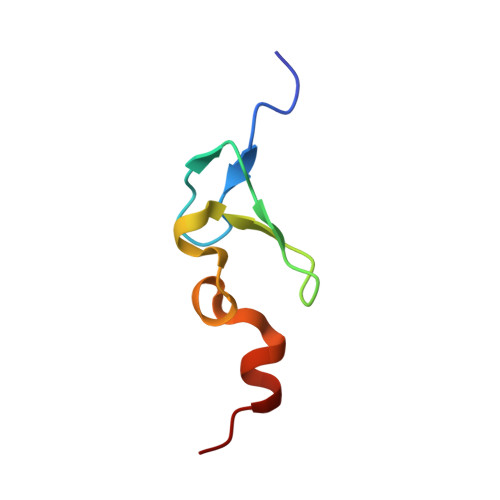Solution Structure of the Cuz1 AN1 Zinc Finger Domain: An Exposed LDFLP Motif Defines a Subfamily of AN1 Proteins.
Sun, Z.J., Bhanu, M.K., Allan, M.G., Arthanari, H., Wagner, G., Hanna, J.(2016) PLoS One 11: e0163660-e0163660
- PubMed: 27662200
- DOI: https://doi.org/10.1371/journal.pone.0163660
- Primary Citation of Related Structures:
5IJ4 - PubMed Abstract:
Zinc binding domains are common and versatile protein structural motifs that mediate diverse cellular functions. Among the many structurally distinct families of zinc finger (ZnF) proteins, the AN1 domain remains poorly characterized. Cuz1 is one of two AN1 ZnF proteins in the yeast S. cerevisiae, and is a stress-inducible protein that functions in protein degradation through direct interaction with the proteasome and Cdc48. Here we report the solution structure of the Cuz1 AN1 ZnF which reveals a compact C6H2 zinc-coordinating domain that resembles a two-finger hand holding a tri-helical clamp. A central phenylalanine residue sits between the two zinc-coordinating centers. The position of this phenylalanine, just before the penultimate zinc-chelating cysteine, is strongly conserved from yeast to man. This phenylalanine shows an exceptionally slow ring-flipping rate which likely contributes to the high rigidity and stability of the AN1 domain. In addition to the zinc-chelating residues, sequence analysis of Cuz1 indicates a second highly evolutionarily conserved motif. This LDFLP motif is shared with three human proteins-Zfand1, AIRAP, and AIRAP-L-the latter two of which share similar cellular functions with Cuz1. The LDFLP motif, while embedded within the zinc finger domain, is surface exposed, largely uninvolved in zinc chelation, and not required for the overall fold of the domain. The LDFLP motif was dispensable for Cuz1's major known functions, proteasome- and Cdc48-binding. These results provide the first structural characterization of the AN1 zinc finger domain, and suggest that the LDFLP motif may define a sub-family of evolutionarily conserved AN1 zinc finger proteins.
Organizational Affiliation:
Department of Biological Chemistry and Molecular Physiology, Harvard Medical School, Boston, Massachusetts, United States of America.















